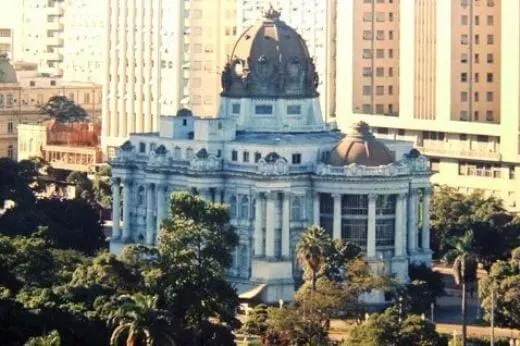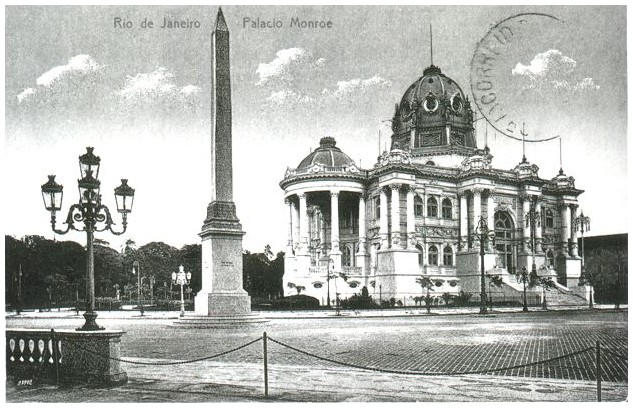Monroe Palace
- Frederico Aversa Masson
- Oct 31, 2024
- 3 min read
Updated: Nov 4, 2024

The Monroe Palace, once situated in the Central Zone of Rio de Janeiro, was originally built in St. Louis, Missouri, acting as the Brazilian Pavillion in the 1903 World Fair. Designed by General Souza Aguiar (who was also an engineer), the palace's innovative, ambitious and ecletic architecture (heavily influenced by Europe's architectural movements) served as a propaganda tool for the newly-formed Republican government, aiming to sell the image of Brazil as a modern and opulent nation to foreigners. With 5,000 cups of coffee (the nation's biggest export then) being served daily at the pavillion, the palace won the Architecteral Prize of the St. Louis World Fair. The building was then dismantled and shipped to Rio de Janeiro.
The palace was rebuilt in the then Avenida Central (now called Avenida Rio Branco) between 1905 and 1906. During this period, Rio was undergoing a major urban renewal plan — the Reforma Pereira Passos. The slums and tenements that marked the views of the Central Zone were demolished, giving place to the Avenida Central — intented to become some sort of Tropical Champs-Élysées — with the Monroe Palace being the crown jewel of the boulevard.
Initially called Palácio São Luís, the building was first used to host the Third Pan-American Conference in 1906. During this event, it was renamed Palácio Monroe, in honor of U.S. President James Monroe (and the Monroe Doctrine of "America for the Americans"), marking the growing approximation of Brazil with the United States. After the conference, the palace served little to no purpose until 1914, when it housed temporarily the Chamber of Deputies.
Right after the 100th anniversary of Brazil's independence, the Federal Government decided to move the Brazilian Senate to the Monroe Palace, following several complaints made by senators against the old Senate house — the Palácio dos Arcos — built in 1826 and extremely deteriorated. After one and a half years of works to adapt the building to its new function, the first Senate session in the Monroe Palace occurred on May 3, 1925. For 35 years, key moments of Brazil's politics and history took place in the Monroe Palace - from the final ruling years of the São Paulo and Minas Gerais' political oligarchies to Getúlio Vargas' Estado Novo to the decision of building a new capital to the nation.
By the 1950's, Monroe Palace seemed too small to house the Senate, and, even before the construction of Brasília, plans of a new Senate house in Rio de Janeiro were being made. With the capital being moved from Rio de Janeiro to Brasília under President Juscelino Kubistchek in 1960, the Senate left the Monroe Palace, which began housing some minor government offices.
With the construction of the Rio de Janeiro Metro in the 1970s, the Monroe Palace faced the risk of demoliton, but, after a major public outcry, the construction company decided to shift the metro line to preserve the palace. However, as Lúcio Costa, the urbanist behind Brasília and the then head of the National Institute of Historic and Artistic Heritage, refused to sign the landmarking act of the Monroe Palace and drew heavy attacks against the palace (which he considered to be an architectural abomination, whose design didn't represent the Brazilian culture), the building faced the bitter end of destruction, having been demolished in 1976 following President Ernesto Geisel's authorization.
Sources & References
Romero, C. (2021, February). A triste história de um palácio demolido. Retrieved from https://www.carlosromero.com.br/2021/02/a-triste-historia-de-um-palacio-demolido.html
Senado Federal do Brasil. (2015, May 4). Que fim levou o Palácio Monroe? Retrieved from https://www12.senado.leg.br/noticias/materias/2015/05/04/que-fim-levou-o-palacio-monroe
Images Credits
Image 1: Augusto Malta | Arquivo Geral da Cidade do Rio de Janeiro/Reprodução. Retrieved from: https://vejario.abril.com.br/coluna/daniel-sampaio/palacio-monroe
Image 2: Retrieved from: https://diariodorio.com/historia-do-palacio-monroe/
Image 3: Arquivo Público do Rio de Janeiro. Retrieved from: https://www12.senado.leg.br/noticias/materias/2015/05/04/que-fim-levou-o-palacio-monroe
Image 4: Retrieved from: http://www.vivercidades.org.br/publique222/cgi/cgilua.exe/sys/start.htm?infoid=1111&sid=21








Comments